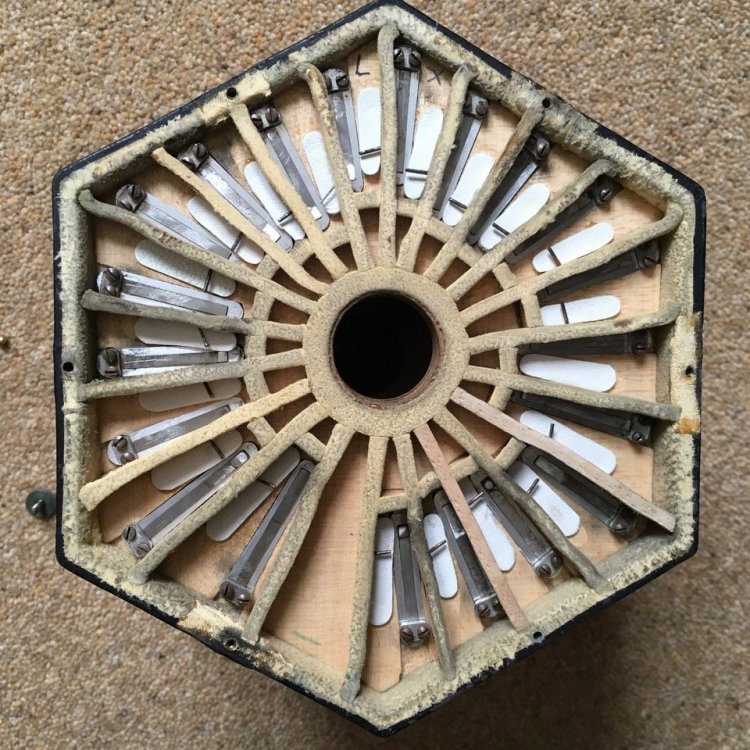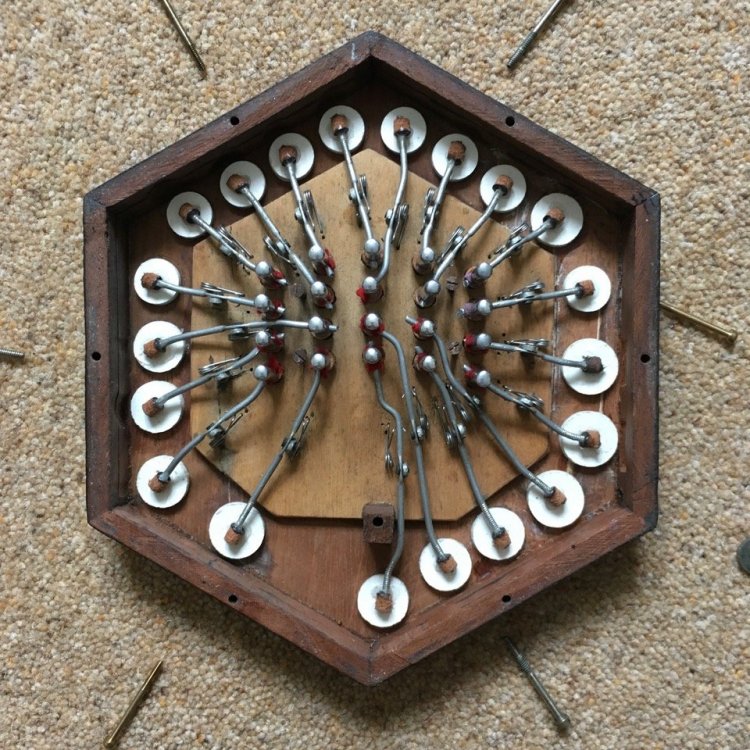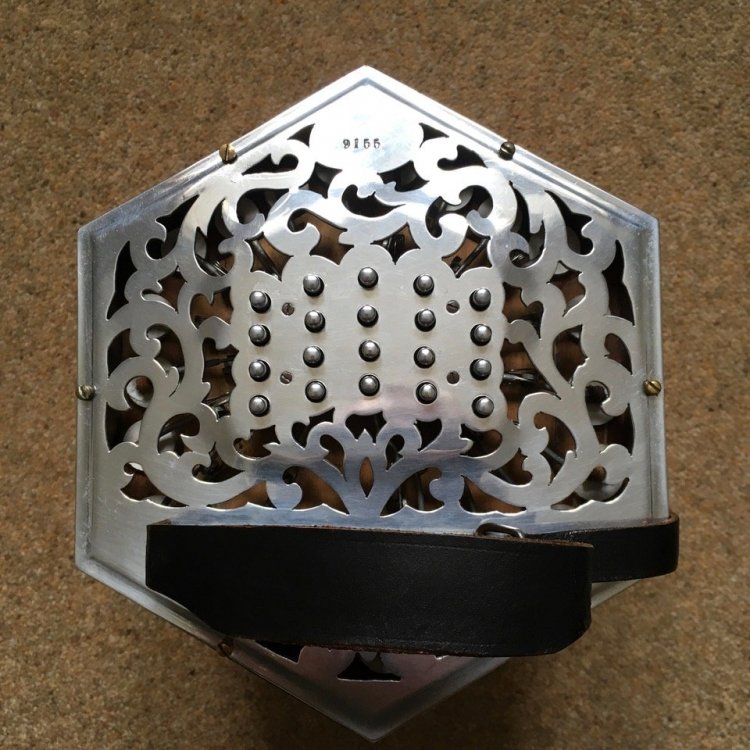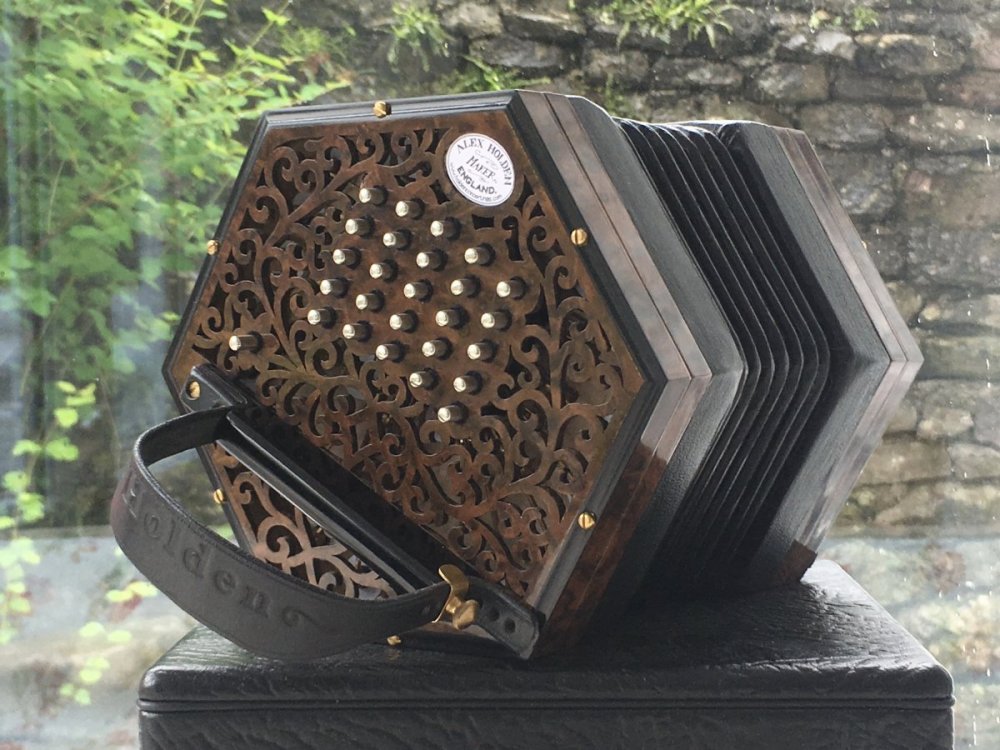-
Posts
551 -
Joined
-
Last visited
Everything posted by Little John
-
Hi Howard, For real confusion try pairing Gathering Peascods with All in a Garden Green - the first four bars are identical! I do actually play this combination (solo) but I play the first in C and the second in G so there's some indication a change has taken place. LJ
-
I found this tune in the excellent Paul Hardy tune book, but dismissed it at first as being harmonically too dull. When I came back to it a couple of months later I realised this could be turned to an advantage - it lends itself to a drone-style accompaniment. I've used open fifths throughout. Looking for a tune to pair with it The Bonny Breast Knot came to mind largely because I had been learning it about the same time. The change in accompaniment lightens the feel and, combined with the change of key, marks a clear break between the two tunes; whilst the fact that the first note is the same as the last in Dr Faustus' Tumblers gives continuity. LJ
-
It's a phenomenon I've experienced too. I think it's more to do with the tonal quality of the sound. It's not just the concertina - a banjo will cut through too. At a recent folk festival I saw a morris side whose musicians consisted of several melodeons and a lone English concertina. From a distance the English shone through, but I bet the player herself felt as if she was drowning in a sea of melodeons. LJ
-
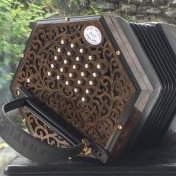
56 keys Tenor Treble English Concertina
Little John replied to mary-louise's topic in General Concertina Discussion
I agree; and an open fifth (or rather a succession of open fifths) held with one finger allows you to play a melody above it; but perhaps it's best to learn to walk before trying to run! LJ -

56 keys Tenor Treble English Concertina
Little John replied to mary-louise's topic in General Concertina Discussion
Using the root triads - the triangles shown in these diagrams - is a starting point, but rather limited. Two variations to consider, right from the start in my view, are: 1. Spread chords. Starting with the triad (triangle) as shown, take out the middle note and instead play it an octave higher (on the other side). Can often sound mellower than the basic triad. 2. First inversion. Starting with the triad as shown take out the bottom note and play it an octave higher (on the other side). These two techniques, along with the root triad, will allow you to play a more satisfying accompaniment where the top note of the chord (or the bottom note or even both) follow a musical progression. LJ -

My Reed Measurement activities
Little John replied to Seth's topic in Instrument Construction & Repair
I know this is off-topic, but ... The UK has still not "gone metric", thankfully. Some weights and measures were metricated, but we have all sorts of delicious exceptions and contradictions. Road distances are still measured in miles and yards, draught beer and cider is still sold in pints. In bottles it has to be metric, but what is 564ml if not a pint? Sheet building materials are still 8 by 4 feet (to line up with existing joist spacing), but the thickness is quoted as 13 or 19mm. And I'm sure most builders still refer to timber measuring 100mm by 50mm as "a bit of four by two". LJ -
Now sold. Usual donation made to this forum. LJ
-
This is a tune I tried to learn thirty odd years ago, but was defeated. I can't remember why, but I can guess. One thing is that it requires the B3 just below C4 (middle C). Since all standard Crane duets from 35 to 55 buttons start at C4 on the right that means picking it up on the left hand side - possible, but a bit of a nuisance. I overcame this in later years by re-tuning one C#4 reed to B3. The other reason was probably that the interval of a fourth, E5 - B4 on which it begins, is awkward for fingering. Over the years I've got more used to this sort of fingering; becoming quite flexible and no longer restricted by the one-finger-per-column approach which one naturally adopts to begin with. I might also add that the accompaniment would be quite limited without the B2 adaptation on the bass side, allowing a low B minor chord. (Standard Cranes start at C3 on the left.) The Holden Crane I'm playing has the B3 (right) and B2 (left) designed in from the start (along with Bb2 and A2, but those are not used in this recording). LJ
- 1 reply
-
- 5
-

-
I've owned this for about five years. Just over a year ago I had it serviced by Alex Holden, including new bushing boards and adjusting the button travel to make them uniform. It was also re-tuned to fifth comma mean tone. After that it became my "go-to" instrument. It's now surplus to requirements as I collected my new Holden 44 button Crane six weeks ago. Better it goes to a good home than gathers dust on my shelf! Photographs and button layout attached. You'll see that I have three buttons modified to extend the left hand down to A2 and the right hand down to B3. These were done professionally, weighting the reed tips with solder, so are easily reversible should you wish it. The raised metal ends, action and reed frames are all aluminium, making it a beautifully light instrument to handle. There are a number of recordings with it on my Instagram account. Here is one: To identify the other recordings on this concertina (all more recent than this) just look for the plain black bellows frames. I'm looking for about £1350. Buyer chooses carrier and pays postage. Includes a padded gig bag. Crabb 48 button Crane.pdf LJ
-
YouTube says the video is unavailable.
-

position while playing effecting tuning
Little John replied to LateToTheGame's topic in General Concertina Discussion
That's right. If the Dipper was tuned to be in pitch at a reasonably high volume then it would be slightly sharp (if anything) at low volume. Maybe the "pros" could detect it was out of tune but mistook sharp for flat. Or maybe they were just having a laugh! LJ -
I suggested I might need a taller hand rest on my new Alex Holden instrument. In the end it is the same height as the old one and it doesn't matter. I think the shorter button travel achieves the same effect as having a taller rest. In any event, this new instrument is extremely easy to play. [Pinky / pinkie - I don't think it matters. In either case the plural would be "pinkies" by the curiosities of the English language!] LJ
-
A slant that brought the buttons closer to the little finger would do that, but the Hayden slant does the opposite - it takes the buttons nearest the little finger furthest away. LJ
-
Some people on some systems seem to prefer not to use their little fingers (pinkies). I play Crane and was inclined that way at first (probably because I came to it from the English), but in the end found it was much better to train myself to use my little fingers. Looking at the note chart for the Hayden I don't see how you could play a scale smoothly without using your little finger - there's always a point where it requires four buttons consecutively in the same row. So if I were thinking to play a Hayden I'd go for the layout that allowed easy use of all four fingers. LJ
-
It is, indeed, a lovely tune. Far be it from me to argue with the mighty JK, but this version seems to be closer to Idbury Hill (Bledington) than the Longborough tune. The Black Book also gives an Oddington dance of the name London Pride, but no tune. However, neither Idbury Hill nor London Pride have "slows", so JK must have invented the C music! LJ
-
Looks like a chevron to me! Have you measured it?
-

Hayden duet that favors flat keys?
Little John replied to Aldon Sanders's topic in General Concertina Discussion
Well, if you were playing just on your own the obvious answer would be to transpose up or down a semitone to a playable key. (E.g. change Db to either C or D). But would this be too difficult for the rest of the orchestra? LJ -
So here it is! My new Holden Crane. It's described in detail on Alex's blog so I won't repeat it here. You'll also find on his blog a medley of tunes. They were recorded only minutes after I'd made the instrument's acquaintance and I was just playing whatever came into my head, so you'll have to forgive a few slips. I've actually had this for a while, but I collected it from Alex on my way to a long holiday so I've been unable to post anything until now; which is probably a good job as I'd have just gushed with enthusiasm for my new acquisition. Instead I've had a fortnight to give it a thorough work-out so I'm able to give a much more considered assessment: this is, quite simply, the best duet I've ever played*. The bellows are supple: no need to "break them in" - they were as flexible as you could wish from the outset. Capacious too - I can play long passages in one direction even using a lot of heavy chording. The reeds are very sensitive. They respond evenly and quickly at very low pressure, so that one can play really quietly but still maintain crispness. They also have a wide dynamic range, so plenty of volume when you need it. This means I can play quietly to sing against then ramp up the volume for a musical interlude. The balance is also excellent. A frequent (almost ubiquitous) complaint of duets (and to some extent anglos) is that the lower notes can overpower the high notes. That's not the case with this one. Certainly from my position as the player (and that's usually the worst position!) the melody never gets lost. Tone is a subjective matter, and Alex generally prefers not to describe the sound of his instruments. I would probably say it sounds "solid and full". Others who have heard the recordings have said variously "what a brilliant rich sound", "very nice, full and open sounding", "marvellous sound ... I very much like the bass side", "Wow! Even on the phone this sounds lovely!" Alex, despite his usual reticence, says in his blog "I am really happy with how rich and well balanced it sounds (even more so in person than recorded on a built in phone mic)". Finally, as a general point, it's really easy to play. The light weight and the lightness of the action contribute to that, but I think it's the result of several factors working together that make it so. I've had the concept of this instrument for many years, and Alex has translated it perfectly into a reality. Having played it for hours, day after day, I can find no fault with it and there's nothing I would change about it. LJ *Possibly the best concertina I've ever played too, but a strong contender for that would have to be the special English built by C&R Dipper which I sold about fifteen years ago when I realised I had neither the time nor the talent to be proficient on two different systems.
-

My experience with 1/5 comma mean tone tuning
Little John replied to Little John's topic in General Concertina Discussion
It depends which accidentals you have on your instrument. If you have and Ab then Ab major should sound good (Ab - C - Eb), but if you haven't (which is probably the case) and have to use G# instead then it will indeed sound awful. G# major will sound awful because the third will be C instead of B#. LJ -

My experience with 1/5 comma mean tone tuning
Little John replied to Little John's topic in General Concertina Discussion
I don't know about just temperament, but in mean tone tuning all whole tone intervals are the same as long as you don't step over the break in the circle of fifths. So in my case C# to Eb and G# to Bb would be much wider than the rest. They would probably be tolerable in a melody and they wouldn't crop up in harmony, so it's not that big a problem. Thirds and fifths are where the real problems lie. LJ -

Whatever Happened To Duet International ?
Little John replied to Irene S.'s topic in General Concertina Discussion
If you're really starving, you'll find quite a few of my efforts here. LJ -
I play with the instrument hanging down. Straps fairly loose the same as when I'm sitting. This was originally recorded to illustrate the shape of the bellows in response to a question, but it serves equally to demonstrate the overall hold on the concertina. Much more comfortable than with forearms horizontal or upright. The only downside is that it can be hard to hear yourself if you're surrounded by melodeons! LJ
-

My experience with 1/5 comma mean tone tuning
Little John replied to Little John's topic in General Concertina Discussion
Steve - it's one of those things, feels like a really big step to take but afterwards you wonder why you didn't do it sooner. I can't really see a downside to it - only benefits. I calculated that, for playing in the "English" keys of G and D it is best to centre the tuning on A. That minimises the deviation from ET. Of course, if you habitually play in other keys than these another centre might be preferable. (If it's a C/G concertina and you play mainly in those keys then D is indeed the appropriate centre for tuning.) See my response above to Bax. My Crane is centred on A so I was able to give a true 440 Hz note to the West Gallery instruments to tune to. That said, if my calculation is correct, his A at 2 cents flat translates to only about 0.5 Hz which I doubt would be noticeable. The "beating" between a true 440 Hz A and the concertina's A would have a two second cycle. -
It's about a year since I asked for others' experience with using fifth comma mean tone tuning in another thread. The answers I received were sufficiently encouraging for me to take the plunge and have my 48 key Crabb Crane duet tuned to this temperament. I haven't regretted it for a moment. A brief explanation before I detail my experience. The almost ubiquitous equal temperament (ET) tuning has been understood for centuries, but was shunned in favour of other tuning temperaments until the end of the 19th century and beginning of the 20th century. In its favour, ET eliminates the need to distinguish between, for example, F# and Gb and it makes it possible to play equally well in any key on a piano or other keyboard instrument. Against it is the fact that all keys are equally "out of tune" and, in particular, all major third intervals are sharp by about a seventh of a semitone (14 cents). Fifth comma mean tone is but one of many tuning systems ("temperaments") which aim to overcome this problem of the major thirds, but it does so at a price: only six of the twelve keys sound good, but all of them are equally good. However, for most folk musicians (and others) this is no real hardship - how many of us want to play in C# major or Eb minor, for example? So, I go to collect my newly tuned Crane from Alex Holden and play a tune. It doesn't sound any different. I deliberately play the "wolf fifth" interval G# - Eb. Doesn't sound bad really. I play a B major chord where the third has to be Eb rather than the D# it should be. Not that bad. Despite not sounding much different, the Crabb almost instantly becomes my "go to" instrument. Only gradually do I realise that my initial perception was coloured by a lifetime of accepting the nasty intervals foisted on us by ET. It's not so much that the mean tone tuning sounds sweeter as time progresses, but that going back to ET tuning becomes increasing painful. The sweetness of mean tone tuning became instantly acceptable whilst the harshness of ET became only slowly apparent. I think instinctively my ear knew this, but my brain took a few months to overcome sixty-odd years prior experience. What follows is a bit more detailed, so you might want to give up at this point! In my earlier thread I asked two specific questions: (1) what keys will I be able to play in and (2) how will it sound with other instruments? The answer to the first is down to your choice of accidentals. For most people Bb, C#, F# and G# will be obvious choices, but the Eb / D# choice is a bit more difficult. (This isn't a problem for English concertinas or larger Hayden duets which have space for both.) Since I tend to sing in flat keys I opted for Eb. This choice gives me the major keys of Bb, F, C, G, D & A plus their relative minors G, D, A, E, B & F#. This would be perfectly adequate were it not for one quirk: some forms of music like to employ the major seventh in minor keys, usually in the harmony rather than the melody (giving rise in classical music to the distinction between harmonic and melodic minor scales). So some tunes in E minor want a D#. It occurs only rarely in my playing and there are several ways round the problem when it does occur, so I really haven't found this to be an issue. As to the second question, over the past year I've played extensively in a duo with a guitar and likewise in a duo with a melodeon. I've also played in a jazz context with clarinet, trombone and guitar and spent a very pleasant day with a West Gallery band and choir including a vast assortment of instruments. I have never detected any problem with sounding out of tune; nor has anyone I've played with made any comment. One further observation. As the title of Ross Duffin's fascination book on the subject indicates, the problem with ET is that it ruins harmony. Melody is a different issue. In the jazz context I've played in Eb major and C minor, where I have to employ G# for what should be Ab, but as I've been playing only melody it hasn't been in the least bit noticeable. One further oddity, which I can't really explain. In a new tune I was learning an odd chromatic passage called for a Bb minor chord. Unfortunately the third of that chord has to be C# since I have no Db, but it sounds acceptable. The same is true of F minor with a third of G# (not that I've ever used that chord). So the flattened minor third seems to be more acceptable than the sharp major third in, for example, B major. Perhaps someone else can provide an explanation for that. One final point. My experience relates entirely to fifth comma mean tone tuning, which seems to be a common compromise: the major thirds are much sweeter than in ET but not actually "pure". In quarter comma the major thirds are pure whilst the fifths are narrower and the note pitches diverge more from ET. How much these last two factors matter I don't know. Some advocate sixth comma as less extreme than quarter or fifth; but my experience suggests fifth comma is not an any practical sense extreme. In all cases the six major and six minor keys are equally good, but perhaps in sixth comma the other keys are more acceptable. That might be an issue with, say, baroque keyboard music but not one that would trouble most folk musicians. I am tempted to try a duet tuned to quarter comma mean tone, but to be honest I'm content with fifth comma so I'll probably never get round to it. My new Alex Holden 44 button Crane (due to arrive next month) will be tuned fifth comma mean tone. LJ
-
Thank you Didie. Since this recording I've changed a couple of chords and added an extra bass run in the second part, but essentially it remains simple.
- 18 replies
-
- roslin castle
- hayden duet concertina
-
(and 1 more)
Tagged with:


